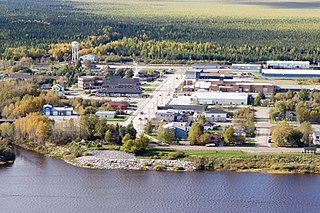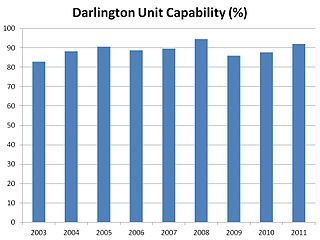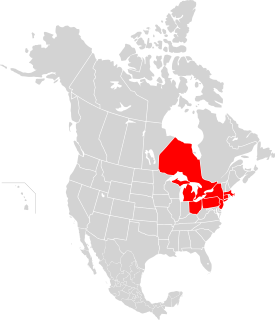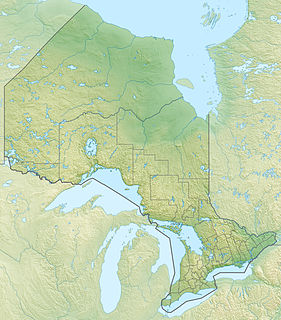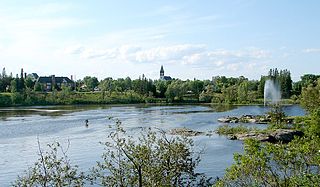| Otter Rapids Generating Station | |
|---|---|
Otter Rapids Dam and Generating Station as seen from the Ontario Northland Railway | |
| Country | Canada |
| Location | Cochrane District, Ontario |
| Coordinates | 50°11′01″N81°38′10″W / 50.18361°N 81.63611°W Coordinates: 50°11′01″N81°38′10″W / 50.18361°N 81.63611°W |
| Status | Operational |
| Opening date | September 26, 1961 |
| Owner(s) | Ontario Power Generation |
| Dam and spillways | |
| Type of dam | Embankment dam |
| Spillways | 1 |
| Spillway type | Controlled chute |
| Power Station | |
| Turbines | 4 x 46 MVA, 60 Hz, 138.4 RPM [1] |
| Installed capacity | 182 MW |
| Website www | |
Otter Rapids Generating Station is a dam and hydroelectric power plant located in Pitt Township [2] in the Unorganized North Part of Cochrane District in Northeastern Ontario, Canada. [3] Owned by Ontario Power Generation, this 4-unit, 182 MW station is part of the Northeast Plant Group. [4] The Ontario Northland Railway runs past this facility. [5]

A dam is a barrier that stops or restricts the flow of water or underground streams. Reservoirs created by dams not only suppress floods but also provide water for activities such as irrigation, human consumption, industrial use, aquaculture, and navigability. Hydropower is often used in conjunction with dams to generate electricity. A dam can also be used to collect water or for storage of water which can be evenly distributed between locations. Dams generally serve the primary purpose of retaining water, while other structures such as floodgates or levees are used to manage or prevent water flow into specific land regions. The earliest known dam is the Jawa Dam in Jordan, dating to 3,000 BC.

Hydroelectricity is electricity produced from hydropower. In 2015, hydropower generated 16.6% of the world's total electricity and 70% of all renewable electricity, and was expected to increase about 3.1% each year for the next 25 years.
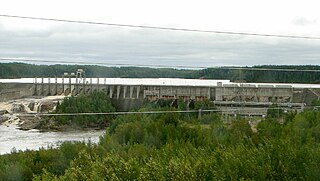
Unorganized North Cochrane District is an unorganized area in the District of Cochrane in northeastern Ontario, Canada. It comprises all parts of the district north of Timmins and Iroquois Falls which are not part of an incorporated municipality.
Contents
Preliminary surveys of the site were conducted in 1945. In 1951 additional site information was gathered with studies and estimates refined. Approval under the Navigable Waters Protection Act was received in October 1958 and the first generating unit came online on September 26, 1961. [4]
The Otter Rapids Generating Station was the last of four generating stations completed on the Abitibi River in the James Bay watershed.

The Abitibi River is a river in northeastern Ontario, Canada, which flows northwest from Lake Abitibi to join the Moose River which empties into James Bay. This river is 540 kilometres (340 mi) long, and descends 265 metres (869 ft).

James Bay is a large body of water on the southern end of Hudson Bay in Canada. Both bodies of water extend from the Arctic Ocean, of which James Bay is the southernmost part. It borders the provinces of Quebec and Ontario. Islands within the bay are part of the Nunavut territory.

A drainage basin is any area of land where precipitation collects and drains off into a common outlet, such as into a river, bay, or other body of water. The drainage basin includes all the surface water from rain runoff, snowmelt, and nearby streams that run downslope towards the shared outlet, as well as the groundwater underneath the earth's surface. Drainage basins connect into other drainage basins at lower elevations in a hierarchical pattern, with smaller sub-drainage basins, which in turn drain into another common outlet.
A community of employees and their families inhabited the adjacent colony called Otter Rapids. This community of over 1,000 people was well equipped with a bank, post office, snack bar, grocery store, billiard hall, bowling alley, curling rink, hockey rink, fire hall, 10-bed hospital and auditorium. [4]

Otter Rapids, also known as White Otter Rapids is an unincorporated place and dispersed rural community in geographic Pitt Township in the Unorganized North Part of Cochrane District in Northeastern Ontario, Canada. It is located 148.9 km south of Moosonee and 120 km north of Smooth Rock Falls.


